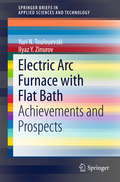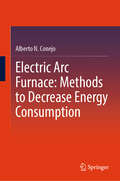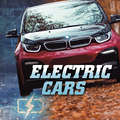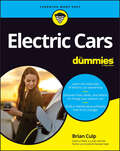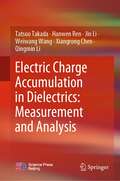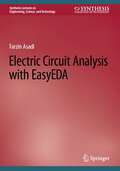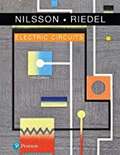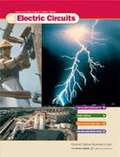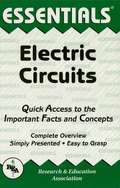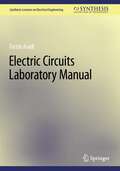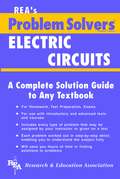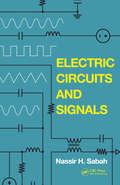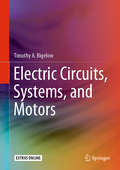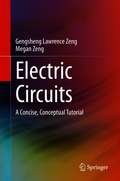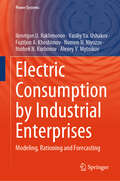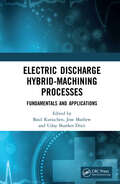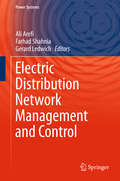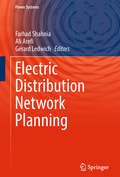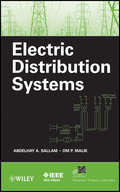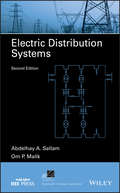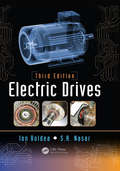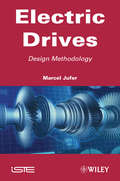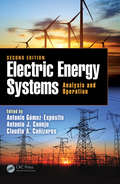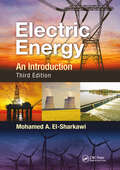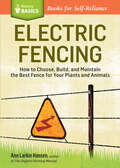- Table View
- List View
Electric Arc Furnace with Flat Bath
by Yuri N. Toulouevski Ilyaz Y. ZinurovThe book contains an analysis of theoretical dependences, bottlenecks and limiting factors of a new technology used in both Consteel and shaft furnaces operating with flat bath. Performances obtained and potentialities of these furnaces are examined. Based on this analysis, a steel melting aggregate of the new type - fuel arc furnace FAF has been developed and offered. In comparison with the best modern electric arc furnaces of identical capacity the productivity of FAF is higher by 36% and electrical energy consumption is lower by a factor of 1. 8. Environment characteristics are considerably improved.
Electric Arc Furnace: Methods to Decrease Energy Consumption
by Alberto N. ConejoThe Electric Arc Furnace (EAF) will become the largest producer of steel worldwide, replacing the conventional route through the blast furnace and BOF. In most developed countries the EAF process is already the main steelmaking reactor. This is due to many advantages, such as much lower emissions of CO₂, higher flexibility in furnace capacity and higher flexibility in the raw materials such as scrap, direct reduced iron (DRI) and pig iron. The EAF process has also experienced a larger level of automation that provides a higher productivity. However, the EAF process also has a large number of limitations in comparison with the BOF, for example; (1) use of an expensive type of energy (electric energy), (2) very poor stirring conditions which results in lower decarburization rates, (3) residual elements in steel scrap, (4) cost of scrap can be higher than iron ore, (5) dependance on DRI to produce higher quality steels, (6) higher heat losses, (7) lower metallic yield (slag leaves the furnace losing iron and heat). If the EAF process overcomes these limitations it will be able to fully overcome the BF-BOF route and become the dominant process for steelmaking in the 21st century. This book discusses in detail 15 methods to decrease energy consumption in the EAF. Decreasing energy consumption requires an integral approach which means that all methods should be fully understood and optimized.
Electric Cars (Wild About Wheels)
by Nancy DickmannA car zips down the street. But you don't hear the engine rumbling. Why? It's an electric car! Electric cars are becoming more common around the world. Young readers will get a basic introduction to the main parts of these vehicles. They will see how electric cars are different from gas-powered vehicles and why electric cars are better for the environment. Get young readers excited about electric vehicles!
Electric Cars For Dummies
by Brian CulpDrive into the 21st century in an electric car With falling cost of ownership, expanded incentives for purchasing, and more model and body type options than ever, it may finally be time to retire the old gas-guzzler and dive into the world of electric car ownership. Electric Cars For Dummies is your guide to becoming lightning powered, reducing your carbon footprint, and saving money on gas while you do it. This book teaches you how to select the battery-charged vehicle that fits your need and budget. It also offers insight into how to maintain your electric car, including answering all your questions about charging your vehicle. Calculate the total cost of ownership, prep your home to become one huge charger, and demystify the battery, the tune-ups and more. Learn the difference in cost of ownership and emissions between electric and gas-powered vehicles Explore your options and find an electric car that fits in your budget Know when and how to charge your vehicle, and what kind of maintenance it needs Figure out how to charge your car on the goThis is the perfect book for new and would-be electric car owners looking for guidance on buying and maintaining one of these super sleek machines.
Electric Charge Accumulation in Dielectrics: Measurement and Analysis
by Jin Li Tatsuo Takada Hanwen Ren Weiwang Wang Xiangrong Chen Qingmin LiThis book mainly introduces how to measure and analyze electric charge accumulation in Dielectrics. By using the PEA and Q(t) methods with the Quantum Chemical Calculation, the charge characteristics of solid dielectrics under different situations are analyzed, which are never discussed in detail by other books. The book contains a large number of experimental and simulation data as illustrations, and thus the reader can understand the theory in the book very easily. Meanwhile, the reader can learn how to use the two methods to measure charge behavior under different conditions and analyze the charge phenomena by Quantum Chemical Calculation.
Electric Circuit Analysis with EasyEDA (Synthesis Lectures on Engineering, Science, and Technology)
by Farzin AsadiThis book explains and focuses on analysis of electric circuits using an up-to-date software package. The book is filled with examples that students will see throughout a standard electric circuit course. This book is a good source to accompany and complete theoretical work of professors. The author provides a single-source for anyone who needs to analyse an electric circuit.
Electric Circuits
by James Nilsson Susan ReidelElectric Circuits, Tenth Edition, is designed for use in a one or two-semester Introductory Circuit Analysis or Circuit Theory Course taught in Electrical or Computer Engineering Departments. This title is also suitable for readers seeking an introduction to electric circuits. Electric Circuits is the most widely used introductory circuits textbook of the past 25 years. As this book has evolved to meet the changing learning styles of students, the underlying teaching approaches and philosophies remain unchanged. MasteringEngineering for Electric Circuits is a total learning package that is designed to improve results through personalized learning. This innovative online program emulates the instructor's office-hour environment, guiding students through engineering concepts from Electric Circuits with self-paced individualized coaching.
Electric Circuits
by National Science Resources CenterElectric Circuits gives 4th and 5th graders an overview of electricity¿how it was discovered, how people put it to work, how it works in living organisms, and what scientists are still learning about it. The book opens with the time-honored story of Benjamin Franklin and his experiments which proved that lightning is a form of electricity. Another story tells of the American inventor Thomas Edison, whose practical application of electricity has helped shape the modern world. One section of this book outlines the path that electricity takes from a power plant to the living room. Finally, the book looks at electricity in nature, from electric eels in the water to lightning in the skies. (Spanish version)
Electric Circuits Essentials
by The Editors of REAREA's Essentials provide quick and easy access to critical information in a variety of different fields, ranging from the most basic to the most advanced. As its name implies, these concise, comprehensive study guides summarize the essentials of the field covered. Essentials are helpful when preparing for exams, doing homework and will remain a lasting reference source for students, teachers, and professionals. Electric Circuits I includes units, notation, resistive circuits, experimental laws, transient circuits, network theorems, techniques of circuit analysis, sinusoidal analysis, polyphase systems, frequency domain analysis, state-variable analysis, Fourier analysis, Laplace transformation, two-port network parameters, discrete systems and z-transforms, topological analysis, and numerical methods.
Electric Circuits Laboratory Manual (Synthesis Lectures on Electrical Engineering)
by Farzin AsadiThis book provides insights into practical aspects of electric circuits. The author provides real-world examples throughout this book. The devices chosen for this book can be found in nearly all laboratories. No expensive measurement devices are used throughout the book. Someone who reads this book has a better understanding of practical aspects of electric circuits. Chapter 1 introduces tools that will be used in the next chapters. Chapter 2 studies the resistors and contains 9 experiments. Chapter 3 studies the digital multimeters and contains 7 experiments. Chapter 4 studies Kirchhoff's voltage/current law, nodal/mesh analysis and Thevenin equivalent circuits. This chapter contains 5 experiments. Chapter 5 studies the first and second order circuits (RC, RL and RLC) and contains 4 experiments. Chapter 6 studies the DC and AC steady state behavior of electric circuits and frequency response of filters and has 5 experiments. Chapter 7 studies magnetic coupling and transformers and contains 3 experiments. Appendix A shows how different types of graphs can be drawn with MATLAB. Appendix B reviews the concept of root mean square.
Electric Circuits Problem Solver (Problem Solvers Solution Guides)
by Editors of REAREA's Electric Circuits Problem Solver Each Problem Solver is an insightful and essential study and solution guide chock-full of clear, concise problem-solving gems. Answers to all of your questions can be found in one convenient source from one of the most trusted names in reference solution guides. More useful, more practical, and more informative, these study aids are the best review books and textbook companions available. They're perfect for undergraduate and graduate studies. This highly useful reference is the finest overview of electric circuits currently available, with hundreds of electric circuits problems that cover everything from resistive inductors and capacitors to three-phase circuits and state equations. Each problem is clearly solved with step-by-step detailed solutions.
Electric Circuits and Signals
by Nassir H. Sabah<p>Solving circuit problems is less a matter of knowing what steps to follow than why those steps are necessary. And knowing the why stems from an in-depth understanding of the underlying concepts and theoretical basis of electric circuits. Setting the benchmark for a modern approach to this fundamental topic, Nassir Sabah’s Electric Circuits and Signals supplies a comprehensive, intuitive, conceptual, and hands-on introduction with an emphasis on creative problem solving. <p>A Professional Education: Ideal for electrical engineering majors as a first step, this phenomenal textbook also builds a core knowledge in the basic theory, concepts, and techniques of circuit analysis, behavior, and operation for students following tracks in such areas as computer engineering, communications engineering, electronics, mechatronics, electric power, and control systems. The author uses hundreds of case studies, examples, exercises, and homework problems to build a strong understanding of how to apply theory to problems in a variety of both familiar and unfamiliar contexts. <p>Your students will be able to approach any problem with total confidence. Coverage ranges from the basics of dc and ac circuits to transients, energy storage elements, natural responses and convolution, two-port circuits, Laplace and Fourier transforms, signal processing, and operational amplifiers. Modern Tools for Tomorrow’s Innovators Along with a conceptual approach to the material, this truly modern text uses PSpice simulations with schematic Capture as well as MATLAB commands to give students hands-on experience with the tools they will use after graduation. <p>Classroom Extras: When you adopt Electric Circuits and Signals, you will receive a complete solutions manual along with its companion CD-ROM supplying additional material. The CD contains a Word file for each chapter providing bulleted, condensed text and figures that can be used as class slides or lecture notes.
Electric Circuits, Systems, and Motors
by Timothy A. BigelowThis textbook provides an introduction to circuits, systems, and motors for students in electrical engineering as well as other majors that need an introduction to circuits. Unlike most other textbooks that highlight only circuit theory, this book goes into detail on many practical aspects of working with circuits, including electrical safety and the proper method to measure the relevant circuit parameters using modern measurement systems. Coverage also includes a detailed discussion of motors and generators, including brushless DC motors, as these are critical topics in the robotic and mechatronics industries. Lastly, the book discusses A/D and D/A converters given their importance in modern measurement and control systems. In addition to covering the basic circuit concepts, the author also provides the students with the necessary mathematics to analyze correctly the circuit concepts being presented. The chapter on phasor domain circuit analysis begins with a detailed review of complex numbers as many students are weak in this area. Likewise, before discussing filters and Bode Diagrams, the Fourier Transform and later the Laplace Transform are explained.
Electric Circuits: A Concise, Conceptual Tutorial
by Gengsheng Lawrence Zeng Megan ZengThis textbook serves as a tutorial for engineering students. Fundamental circuit analysis methods are presented at a level accessible to students with minimal background in engineering. The emphasis of the book is on basic concepts, using mathematical equations only as needed. Analogies to everyday life are used throughout the book in order to make the material easier to understand. Even though this book focuses on the fundamentals, it reveals the authors' deep insight into the relationship between the phasor, Fourier transform, and Laplace transform, and explains to students why these transforms are employed in circuit analysis.
Electric Consumption by Industrial Enterprises: Modeling, Rationing and Forecasting (Power Systems)
by Alexey V. Mytnikov Ikromjon U. Rakhmonov Vasiliy Ya. Ushakov Foziljon A. Khoshimov Numon N. Niyozov Nurbek N. KurbonovThis book comprises eleven chapters, consistently highlighting key aspects of addressing the challenge of enhancing electricity consumption efficiency within various industrial sectors. It delves into issues such as improving the accuracy of energy intensity calculations for industrial products, estimating electricity consumption for internal needs, and identifying key influencing factors. The methods for determining standard values through multifactor analysis and cost minimization are presented. Furthermore, it examines potential avenues for electricity savings and methods for assessing their impact on the technological and organizational operating conditions of industrial enterprises. The reduction of specific power consumption through optimization of raw materials and semi-finished products parameters is also explored. This book is intended for engineering professionals and researchers in the field of industrial energy management, as well as undergraduate and graduate students specializing in this area.
Electric Discharge Hybrid-Machining Processes: Fundamentals and Applications
by Basil KuriachenThis book provides the knowledge and insight into the fundamental aspects of Electric Discharge Machining (EDM) processes and various hybrid machining technologies derived to improve the machining efficiencies. Fundamental theory of material removal, recent research trends and future research directions have been covered in each chapter. After explaining EDM, Dry and Near-dry EDM processes, Electrochemical Spark Machining, Arc Machining processes, Electric Discharge Hybrid-Turning processes, Electrical Discharge Grinding, Electric Discharge Milling, and various assisted EDM processes have been discussed. Finally, modeling and simulation of hybrid machining processes are also included. The book reflects the recent developments and trends in electric discharge hybrid machining processes. It covers in detail the basics of EDM, various hybrid and assistive technologies in EDM. It includes the updated discussion on the significance of process parameters in various hybrid EDM processes. An overview of modelling and simulation of hybrid EDM process is provided. This book is aimed at Graduate students, researchers in manufacturing engineering, production engineering, and materials engineering.
Electric Distribution Network Management and Control (Power Systems)
by Farhad Shahnia Ali Arefi Gerard LedwichThis book highlights the recent research advances in the area of operation, management and control of electricity distribution networks. It addresses various aspects of distribution network management, including operation, customer engagement and technology accommodation. Electricity distribution networks are an important part of the power delivery system, and the smart control and management of distribution networks is vital in order to satisfy technical, economic, and customer requirements. A new management philosophy, techniques, and methods are essential to handle uncertainties, security, and stability associated with the integration of renewable-based distributed generation units, demand forecast and customer needs. This book discusses these topics in the context of managing the capacity of distribution networks while addressing the future needs of electricity systems. Furthermore, the efficient and economic operation of distribution networks is an essential part of management of system for effective use of resources, and as such the also addresses operation and control approaches and techniques suitable for future distribution networks.
Electric Distribution Network Planning (Power Systems)
by Farhad Shahnia Ali Arefi Gerard LedwichThis book highlights the latest research advances in the planning and management of electric distribution networks. It addresses various aspects of distribution network management including planning, operation, customer engagement, and technology accommodation. Given the importance of electric distribution networks in power delivery systems, effectively planning and managing them are vital to satisfying technical, economic, and customer requirements. A new planning and management philosophy, techniques, and methods are essential to handling uncertainties associated with the integration of renewable-based distributed generation, demand forecast, and customer needs. This book covers topics on managing the capacity of distribution networks, while also addressing the future needs of electric systems. The efficient and economical operation of distribution networks is an essential aspect of ensuring the effective use of resources. Accordingly, this book addresses operation and control approaches and techniques suitable for future distribution networks.
Electric Distribution Systems
by Abdelhay A. Sallam Om P. MalikThis book provides a comprehensive treatment of electric distribution systems. Few books cover specific topics in more depth and there is hardly any book that deals with the key topics of interest to distribution system engineers. The book introduces these topics from two points of view: 1) The practical point of view by providing practical examples and the problems which can be solved. 2) The academic point of view where the analysis and various techniques used for distribution system planning are explained. The most outstanding feature of this book is a combination of practical and academic explanation of its contents. Another outstanding feature is a collection of the traditional and current topics of distribution systems condensed into one book. The reader will gain an understanding of distribution systems from both practical and academic aspects, will be able to outline and design a distribution system for specific loads, cities, zones, etc.. Readers will also be able to recognize the problems which may occur during the operation of distribution systems and be able to propose solutions for these problems.
Electric Distribution Systems (IEEE Press Series on Power Engineering #45)
by Abdelhay A. Sallam Om P. MalikA comprehensive review of the theory and practice for designing, operating, and optimizing electric distribution systems, revised and updated Now in its second edition, Electric Distribution Systems has been revised and updated and continues to provide a two-tiered approach for designing, installing, and managing effective and efficient electric distribution systems. With an emphasis on both the practical and theoretical approaches, the text is a guide to the underlying theory and concepts and provides a resource for applying that knowledge to problem solving. The authors—noted experts in the field—explain the analytical tools and techniques essential for designing and operating electric distribution systems. In addition, the authors reinforce the theories and practical information presented with real-world examples as well as hundreds of clear illustrations and photos. This essential resource contains the information needed to design electric distribution systems that meet the requirements of specific loads, cities, and zones. The authors also show how to recognize and quickly respond to problems that may occur during system operations, as well as revealing how to improve the performance of electric distribution systems with effective system automation and monitoring. This updated edition: • Contains new information about recent developments in the field particularly in regard to renewable energy generation • Clarifies the perspective of various aspects relating to protection schemes and accompanying equipment • Includes illustrative descriptions of a variety of distributed energy sources and their integration with distribution systems • Explains the intermittent nature of renewable energy sources, various types of energy storage systems and the role they play to improve power quality, stability, and reliability Written for engineers in electric utilities, regulators, and consultants working with electric distribution systems planning and projects, the second edition of Electric Distribution Systems offers an updated text to both the theoretical underpinnings and practical applications of electrical distribution systems.
Electric Drives
by Syed A. Nasar Ion BoldeaElectric Drives provides a practical understanding of the subtleties involved in the operation of modern electric drives. The Third Edition of this bestselling textbook has been fully updated and greatly expanded to incorporate the latest technologies used to save energy and increase productivity, stability, and reliability. Every phrase, equation, number, and reference in the text has been revisited, with the necessary changes made throughout. In addition, new references to key research and development activities have been included to accurately reflect the current state of the art. Nearly 120 new pages covering recent advances, such as those made in the sensorless control of A.C. motor drives, have been added; as have two new chapters on advanced scalar control and multiphase electric machine drives. All solved numerical examples have been retained, and the 10 MATLAB®–Simulink® programs remain online. Thus, Electric Drives, Third Edition offers an up-to-date synthesis of the basic and advanced control of electric drives, with ample material for a two-semester course at the university level.
Electric Drives: Design Methodology
by Marcel JuferAn electric drive that is designed or adapted to a specific application must take into account all the elements of the chain of constituent elements in its use and deployment. In addition to the motor, the transmission, power electronics, control, sensors, and electrical protection systems must be taken into account. The motor and the transmission can be optimized and designed to obtain the best energy efficiency assessment, in particular for dynamic nodes. An inventory and a characterization of these various components is proposed as part of this book’s examination and explanation of the different technology elements, as well as a dynamic model of the system, with the whole system constituting a methodology for integrated electric drive design.
Electric Energy Systems: Analysis and Operation (Electric Power Engineering Series)
by Antonio Gómez-Expósito, Antonio J. Conejo and Claudio A. CañizaresElectric Energy Systems, Second Edition provides an analysis of electric generation and transmission systems that addresses diverse regulatory issues. It includes fundamental background topics, such as load flow, short circuit analysis, and economic dispatch, as well as advanced topics, such as harmonic load flow, state estimation, voltage and frequency control, electromagnetic transients, etc. The new edition features updated material throughout the text and new sections throughout the chapters. It covers current issues in the industry, including renewable generation with associated control and scheduling problems, HVDC transmission, and use of synchrophasors (PMUs). The text explores more sophisticated protections and the new roles of demand, side management, etc. Written by internationally recognized specialists, the text contains a wide range of worked out examples along with numerous exercises and solutions to enhance understanding of the material. Features Integrates technical and economic analyses of electric energy systems. Covers HVDC transmission. Addresses renewable generation and the associated control and scheduling problems. Analyzes electricity markets, electromagnetic transients, and harmonic load flow. Features new sections and updated material throughout the text. Includes examples and solved problems.
Electric Energy: An Introduction, Third Edition (Power Electronics And Applications Ser.)
by Mohamed A. El-SharkawiThe search for renewable energy and smart grids, the societal impact of blackouts, and the environmental impact of generating electricity, along with the new ABET criteria, continue to drive a renewed interest in electric energy as a core subject. Keeping pace with these changes, Electric Energy: An Introduction, Third Edition restructures the trad
Electric Fencing: How to Choose, Build, and Maintain the Best Fence for Your Plants and Animals. A Storey BASICS® Title (Storey Basics)
by Ann Larkin HansenProtect your livestock and gardens with electric fencing. In this Storey BASICS® guide, Ann Larkin Hansen describes the pros and cons of different varieties of electric fencing so that you can choose the fence that best suits your property and needs. You’ll also learn how electric fencing works and how to put it together yourself. Whether you’re looking for a standard design to reign in your flock or a portable version for rotational grazing, this accessible volume will help you find an efficient, cost-effective solution.
